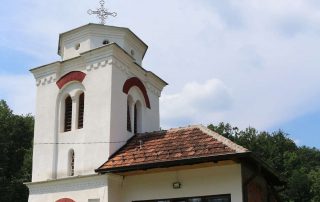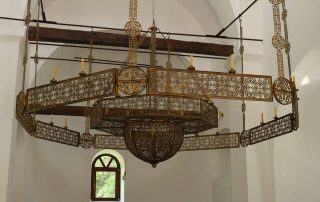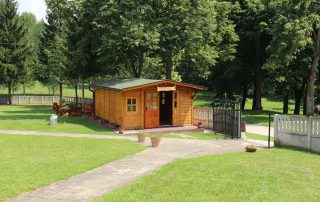MONASTERY OF THE ST. PETER AND PAUL IN THE GRABOVO NEAR RAZANJ
14th century monastery. It existed before the Battle of Kosovo, which means that 110 years before the discovery of America, a liturgy was served here. It was a male monastery, monks lived there. The founder of the monastery is Pavle Orlović, that is, the Duke of Crepa, sung in folk songs as Pavle Orlović. In the famous picture, a Kosovo girl sings a hero, that is the hero. He was a flag bearer in the army of Emperor Lazarus. Before the Battle of Kosovo, nobles from the court from Kruševac came to Bukovik to hunt. The monastery is located at the foot of Mount Bukovik and Mount Ozren. Ozren and Soko Banja are 5 km away by air, so the air is exceptional. The noblewoman came to these parts to hunt, those hunts lasted for months and not like today, she came in the morning by jeep and returned in the evening.
There is a spring here, there was water and it is assumed that thanks to that water and the flatter terrain, they first built a boarding house here, a hunting lodge, so that they would have a place to stay during the hunts. After that, immediately, as it was at that time, an endowment was made, that is, a church. Afterwards, monks lived there. The church was destroyed twice and burned by the Turks. It was last burned in the 16th and 17th centuries and then rebuilt under the leadership of Karadjordje, sometime in the late 18th and early 19th centuries. At that time, unfortunately, it was no longer a monastery because the last invasion of the Turks drove away the monks, there were about 30 of them, and they fled to Bulgaria. From then on, from Karadjordjevic until 2014, this church served as a parish church for the surrounding villages. The priest came here several times a year to serve. Until the formation of the Kruševac diocese, it served as a parish church. When the diocese was formed, then the bishop, Mr. David, chose to return this place to its original condition, to be a monastery again, and it was determined that it would be a nunnery. So, from 2014, the nuns came to the monastery, and from 2015, the 3rd renovation begins, because in those 200 years, while it served as a parish church, a lot of moisture and lodgings also failed because no one has ever lived there. Especially during the last war, there was a big explosion in Paracin, it damaged the church a lot because it was felt even there and it was broken into 2 parts. Then the nuns thought for a year about the renovation and the approaching renovation to see how they could save her. The recommendations were to demolish it and build a new one, but they managed to find professional masters and adequate architects who carried out those works, so it was not demolished. This is the first time in 5 years that the church is no longer lined with scaffolding and can be entered.
The renovation continues because now the frescoes are following, but the church is capable of living. The nuns try to organize their everyday life in addition to the renovation, so that they have their own products, rosaries, icons. They try to take everything that nature gives them and not to enter the race with the industry, they produce brandy and fruit syrups. Everything is organic, fruits and vegetables are watered exclusively with spring water and are made according to the simplest and oldest recipes known to them. Now they have the famous cream from Gavez, a balm, which turned out to be good and they make a balm from Nevena. Their glycerin soaps (medical) are well-known, as well as homemade lard (laundry) soaps. They do everything themselves, by hand and most importantly, everything is done with prayer and blessing, so that it gives a special quality. The basement room in the konak was turned into a chapel, a chapel, because the church was in scaffolding so it could not serve. This smaller one still remains in service today as a winter church for weddings, baptisms… The monastery has great wealth, fragments of relics. They have 65 particles of Russian saints and frequent relics of the apostles Andrew, Philip Nestor, Saint Demetrius, John the Baptist. Recently, with the blessing of the Bishop, they received a part of the relics of Saint Nectarios of Aegina. They also have a replica of the Jerusalem icon of the Mother of God, which arrived directly from Jerusalem with a small stone from the tomb of the Mother of God. At the time when she lived and was buried, there were no photographs, so the apostle Luke drew it at the place where she was buried, and it is an icon that is considered the most authentic. How the apostle Luke lived with the Mother of God, he knew personally, is considered the most credible. It is decorated with 300 zircons and 23 semi-precious stones, and is 1×1.40 m in size. The liturgy is served on Saturdays, Sundays and holidays. In the monastery there are places for lodgings and longer stays. The porch can accommodate 140 people and have lunch. These are the smallest monasteries in this series of monasteries located nearby.










